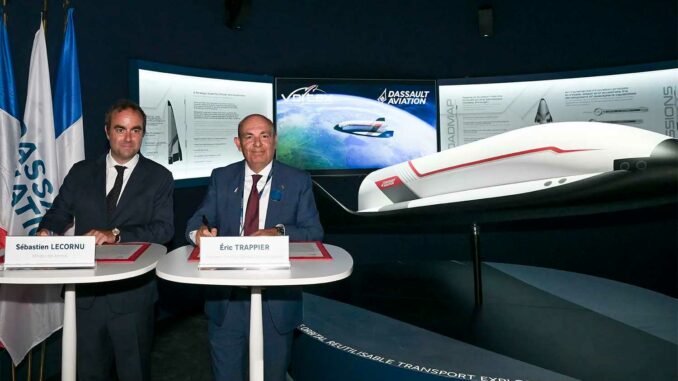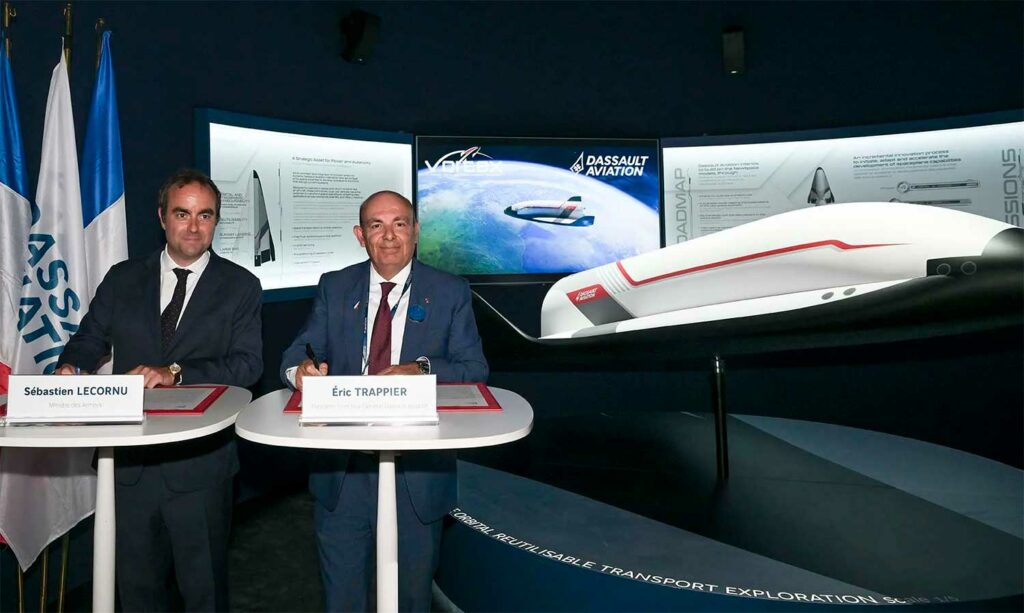
The French Ministry of Armed Forces and Dassault have signed an agreement to develop the Vortex-D space demonstrator, focused on hypersonic flight.
At the 2025 Paris Air Show, the French Ministry of Armed Forces formalized a support agreement with Dassault Aviation to develop the Vortex-D demonstrator, a reusable space plane. Designed to validate hypersonic flight and atmospheric reentry technologies in flight, this project is part of a rapid and economical approach inspired by Newspace. The objective is twofold: to overcome the major technological barriers to piloted space vehicles and to assert French strategic sovereignty in the space domain. The program builds on the achievements of the Hermès, X-38 and IXV projects and is intended as an evolving platform that can be used for military, commercial or scientific missions. This approach marks a turning point in French industrial strategy, focusing on agility and public-private synergy.
A strategic partnership between the government and industry for Vortex-D
The Vortex-D project is based on a strategic agreement between Dassault Aviation and the French Ministry of the Armed Forces, which was formalized at the 2025 Paris Air Show. This support agreement aims to launch a space demonstrator capable of validating, in real flight, several critical technological building blocks in the field of hypersonic flight and controlled atmospheric reentry.
Dassault Aviation’s role in this partnership is no coincidence. The French manufacturer has technical experience accumulated since the 1980s on several European space programs: the Hermès space plane, the X-38 rescue capsule for NASA, and the ESA’s IXV demonstrator. Although these projects have sometimes remained at the prototype or single test stage, they have enabled Dassault to establish specific expertise in transatmospheric aerodynamics, thermostructural materials and inertial guidance.
On the government side, this initiative is part of a strategy to maintain strategic autonomy and technological sovereignty. The ability to develop an independent, reusable space launch vehicle piloted from national territory is a key issue in a context marked by the growing militarization of space.
In the medium term, this program could strengthen France’s ability to develop tactical launch or observation platforms capable of returning to Earth without relying on external actors.
A technology demonstrator dedicated to hypersonic flight
The Vortex-D is primarily a technological experimentation tool. Its main objective is to validate in flight critical components for hypersonic flight (speeds exceeding Mach 5, or more than 6,000 km/h) and atmospheric reentry, two complex and strategic areas. At these speeds, the vehicle’s structure is subjected to temperatures of over 1,000°C, requiring innovations in composite materials, thermal protection and high-frequency inertial guidance.
The program is distinguished by a clear desire to reduce technical uncertainties before any operational deployment. This involves the integration of sensors, on-board cameras, and high-density data recovery systems.
This incremental approach would make it possible, within three years, to improve the reliability of re-entry trajectories, on-board control devices, and propulsion systems for phases in dense and rarefied atmospheres.
The Vortex-D is not intended to be a final product, but rather a flexible test platform. It could incorporate different configurations as the program progresses, for example to test ceramic fins, new insulation materials, or autonomous navigation software. As such, it serves as a technology accelerator, reducing development times for future operational vehicles.

A Newspace-inspired method for a national project
The project is inspired by Newspace, an industrial trend that favors rapid, iterative, and low-cost execution. The goal is clear: to avoid the delays and excessive costs that have often characterized European public space programs, such as Ariane 6 and the former Hermès shuttle.
With this in mind, Dassault and its partners are focusing on modular development, shorter validation cycles, and vertical integration of industrial skills. The initial schedule calls for completion within three years, which is much faster than the average for traditional space projects (often 5 to 10 years).
The exact cost of the project has not been disclosed, but a hypersonic demonstrator of this type can cost between $150 million and $300 million, depending on the components tested and the number of flights carried out.
The approach adopted also makes it possible to use smaller, more agile subcontractors and artificial intelligence-assisted design methods to speed up aerodynamic simulation and thermal resistance testing.
This paradigm shift could herald a fundamental reform of the management of French space programs, which are often criticized for their rigidity. Public-private cooperation is becoming a lever for technical competitiveness.
Long-term civil, military, and commercial applications
The modular nature of the Vortex-D paves the way for several future uses. Dassault Aviation has not ruled out offering variants of the aircraft for military orbital surveillance missions, reusable microsatellite launches, or even scientific or commercial uses.
For the Department of Defense, this approach could, in the medium term, provide tactical orbital access, particularly in contexts where satellite availability is limited. A space drone capable of temporarily placing a sensor in low orbit and then returning would provide a major strategic advantage.
On the civilian side, applications such as suborbital tourism, ultra-fast delivery of sensitive cargo, and the provision of environmental data could benefit from these advances.
In a context where the United States (SpaceX Starship), China (Tengyun spaceplane) and India (RLV-TD) are investing in the same field, France is seeking to remain in the race for reusable space vehicles, particularly in the face of US dominance in commercial launches.
The Vortex-D could therefore be the starting point for a national range of space planes, designed to evolve and meet a variety of needs. Feedback from each flight will guide future decisions on a possible operational program.
Towards a redefinition of French space strategy
Support for the Vortex-D reflects a broader strategic shift in French space policy. Faced with the rise of Russian, Chinese, and American military space capabilities, Paris is seeking to consolidate an autonomous technological base focused on reusability, operational flexibility, and disruptive innovation.
Cooperation between the state and a private industrial player such as Dassault offers a more agile model than cumbersome state-owned consortia (such as those of the ESA). This type of partnership could become a benchmark for other programs, particularly in the fields of orbital drones, hypersonic missiles, and smart satellites.
This approach is in line with the momentum created by the creation of the Space Command within the French Air Force, which has been responsible for steering military space strategy since 2019.
France invests around $5 billion per year in its space program (including civil and military), but the share devoted to disruptive technological innovations remains small. The Vortex-D project could help to rebalance this allocation.
Finally, on the diplomatic front, this project strengthens France’s technical credibility within NATO and the ESA, and could position Dassault as a leading European space player alongside ArianeGroup and Airbus Defence and Space.
War Wings Daily is an independant magazine.